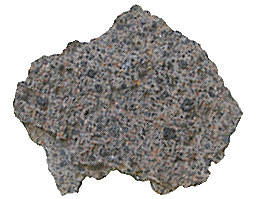
Igneous Rock Examples
Igneous rock composition and texture Ask GeoMan.How do composition and texture relate to igneous rocks?Igneous rocks are crystalline solids which cool from magma: the of solid rock. Magmas occur atdepth in the crust, and are said to exist in 'magma chambers,'a rather loose term indicating an area where the temperature is great enoughto melt the rock, and the pressure is low enough to allow the materialto expand and exist in the liquid state. Many different types of igneousrocks can be produced.
The key factors to use in determining which rockyou have are the rock's texture and composition.TextureTexture relates to how large the individual mineral grains are in thefinal, solid rock. In most cases, the resulting grain size depends on howquickly the magma cooled. In general, the slower the cooling, the largerthe crystals in the final rock. Because of this, we assume that coarsegrained igneous rocks are 'intrusive,' in that they cooled atdepth in the crust where they were insulated by layers of rock and sediment.Fine grained rocks are called 'extrusive' and are generally producedthrough volcanic eruptions.Grain size can vary greatly, from extremely coarse grained rocks withcrystals the size of your fist, down to glassy material which cooled soquickly that there are no mineral grains at all. Coarse grain varieties(with mineral grains large enough to see without a magnifying glass) arecalled phaneritic. Granite and gabbro are examples of phaneritic igneousrocks. Fine grained rocks, where the individual grains are too small tosee, are called aphanitic.

Basalt is an example. The most common glassyrock is obsidian.
Oct 10, 2019 Igneous rocks form when magma (molten rock) cools and crystallizes, either at volcanoes on the surface of the Earth or while the melted rock is still inside the crust. All magma develops underground, in the lower crust or upper mantle, because of the intense heat there. The room three free download. Igneous rocks can have many different compositions, depending on the magma they cool from.
Obviously, there are innumerable intermediate stagesto confuse the issue.CompositionThe other factor is composition: the elements in the magma directly affectwhich minerals are formed when the magma cools. Again, we will describethe extremes, but there are countless intermediate compositions. (Compositionrelates to the terms discussedin another question. If these terms are confusing, please before continuing.)The composition of igneous magmas is directly related to where the magmais formed. Magmas associated withare generally mafic, and produce basalt if the magma erupts at the surface,or gabbro if the magma never makes it out of the magma chamber. It is importantto remember that basalt and gabbro are two different rocks based purelyon textural differences - they are compositionally the same.Intermediate and felsic magmas are associated with. In these areas, mafic seafloor basalt andcontinental sediments are subducted back into the crust, where they re-melt.This allows the process tocontinue, and the resulting magma is enriched in the lighter elements.
Intermediatemagmas produce diorite (intrusive) and andesite (extrusive). Felsic magmas,the final purified result of the differentiation process, lead to the formationof granite (intrusive) or rhyolite (extrusive).Click for a chart summarizing theclassification of igneous rocks. You are GeoManiac number since April 1, 1997.